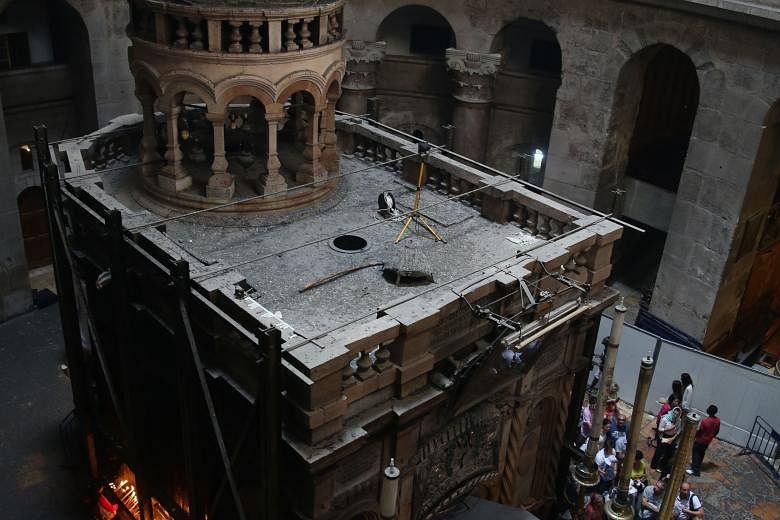JERUSALEM • Work has begun to save the holiest shrine in Christendom. It won't be a simple patch- and-paint job.
This is the alpha and omega of restoration projects. They are going to repair Jesus' tomb - with titanium bolts.
During the next nine months, a team of Greek conservationists will restore the collapsing chapel built above and around the burial cave where the faithful believe that Jesus was buried and rose from the dead after the Crucifixion.
To fix the chapel, which is buckling under its own weight, the crew will have to enter a few square metres of the ruins of the first-century tomb. It is called the Holy Rock.
To get there, they will clean centuries of candle soot left from votive lamps; they will reset and anchor the imported marbles; and they will inject 21st-century stabilising mortar into 12th-century masonry from the Crusader times.

And at the heart of the edifice, in the centre of the Church of the Holy Sepulchre in the Old City of Jerusalem, they will lift the slab where millions of pilgrims have knelt and prayed, where the salt of tears and the wet of sweat have smoothed and worried the hardest stone. And for the first time in more than 200 years, they will look inside.
The ruins of what is believed to be a rock-cut tomb are being breached because the chapel built above is falling apart.
Its repair is decades overdue. After years of squabbling among the Christian communities who occupy the site, work to restore the edifice began earlier this month.
The conservationists - whose jobs have included repairing the Acropolis in Athens - are unsure what they will find.
"This is the most alive place we have ever worked," said Dr Antonia Moropoulou, a leader of the team from the National Technical University of Athens. "We will see what we see."
The conservation team has already probed the chapel and tomb with ground-penetrating radar and laser scanners.
They are flying drones with cameras above the indoor site now, which - like flying drones around the Vatican or Mecca - is not easy. They have detected a fracture in the rock of the tomb, unknown until now.
They believe that the crack is the result of stresses put on the rock by the columns supporting a cupola above. Still, no modern scientist has ever looked inside.
Archaeology at the Church of the Holy Sepulchre has been limited, not only by protective clerics but also by centuries of tradition. The site is considered the most sublime in Christendom, a place of pilgrimage, faith, passion and mystery - not digging and probing.
Patriarch Theophilos III, of the Orthodox Church of Jerusalem, said: "There is no doubt that there is some kind of energy. I don't want to describe it, but some kind of energy that emanates from this place."
British archaeologist Martin Biddle, who studied the site in the 1990s, speculated that there could be ancient graffiti left by pilgrims somewhere around the Holy Rock or beneath the floor under the rotunda, perhaps scribbles of "He is risen!"
The Greek team has promised to keep the church open to visitors and pilgrims throughout the restoration, meaning its members will be working in the deep of the night, the site lit by their own portable generators and a hundred vigil lamps.
"This is a very challenging environment. Very profound, yet very exciting," said Dr Moropoulou, adding that she is both an engineer and a believer. "This is a serious undertaking. We know very well where we are, and we know what we are doing."
It is the place, said Theophilos III, "where heaven and earth meet".
THE WASHINGTON POST


